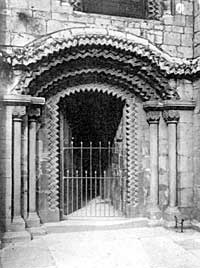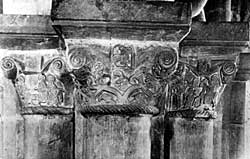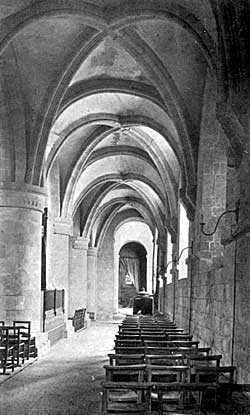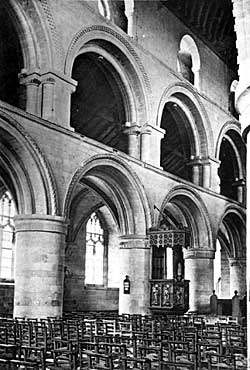The elevation of the transepts, like that of the nave, is in three stages, the round-headed windows of the nave and the circular lights of the clerestory being continued in the lowest and uppermost stages, while, owing to the absence of aisles, tall round-headed windows take the place of the triforium in the middle stage.1 There is an internal passage in front of the window openings at the triforium level, and the clerestory passage is continued round the transepts. During the 15th century, the window openings of the middle or triforium stage were filled with tracery, now removed. The passage at the triforium level in the north and east walls of the north transept formed the way to the upper floors of the central tower: over the doorway in the north-west corner of the transept is a piece of rough sculpture, evidently an insertion, which is supposed with reason to have formed part of a tympanum in the Saxon minster.

Doorway in south transept—Southwell
Allusion has already been made to the comparatively late Norman date of the work in much of the church. An examination of the details of the transepts will make this only more evident. Three features at any rate, which point to a fairly advanced date, are apparent upon the outside of the building. These are (1) the inner frame of chevron ornament, which surrounds the window openings, inside their shafted jambs and arches.2 (2) The extremely elaborate doorway in the south transept, round the head of which, as already shown, the chevron string-course is continued to form a hood. The doorway has a flat segmental head, and the actual opening, like those of the windows, is framed within a continous band of chevron. Between this and the hood are two recessed orders of chevron ornament supported by plain cylindrical shafts, the heads of which are scalloped, and the flat surfaces worked with incised ornament. (3) One very noticeable feature of the transepts is the carving of the whole surface of the gable-ends with bands of zig-zag broken by small circles. These are incised upon the north side of the church, but are in relief on the south.3 It is possible that this work, begun in the north transept, and developed in the south, may have supplied the suggestion for the even more richly carved gables of the chambers which flanked the lower part of the western towers at Lincoln.4 The date of the completion of the Norman towers at Lincoln is now thought by the best authorities to be some years later than the middle of the 12th century5: this work at Southwell is of an advanced type of Norman ornament which certainly cannot be much earlier. Taken into account with the prevalence of well-cut and multiplied chevron ornament throughout the whole design, and with its rich employment in the south doorway, this work forbids us to accept a date earlier than 1140 for the completion of the transepts. Were it not that the shafting of the windows and doorway is still plain and free from ornament, an even later date might be claimed for it.

Capitals—Eastern arch of tower—Southwell
The piers of the central tower, at any rate, as well as the immediately adjacent parts of the transept, were probably completed, as has been already noted, as part of the earlier work.6 The north and south arches, communicating with the transepts, are carried by tall semi-circular responds, with undivided capitals like those of the nave columns. The inner jambs of the eastern and western arches, on the other hand, are shafted in harmony with the orders of the arches above.
The heavy soffit rolls in each have their own shafts on the faces of the piers, Angle-shafts in the jambs correspond to an elaborate band of moulding in each arch, which has sometimes been compared to a series of fir-cones carved in stone, but is in reality a cable moulding with unusually deep incisions between the twistings of the strands. Each arch has further an outer edge-roll, carried on string-courses formed by the continuation of the abaci of the angle-shafts along the eastern and western faces of each pier. These string-courses are continued further round the projecting surface of the piers, to carry a flat hood-moulding which, like the hoods of the triforium arches, is carved with rows of minute hatching. The north and south arches of the tower are similar to those on the east and west sides. But, while the capitals of the shafted piers which bear the western arch, and of the responds of the northern and southern arches are simply scalloped, those of the shafts of the eastern arch are elaborately carved with volutes at their angles; while the lower portions of the capitals have broad flat bands sculptured with interlacing foliage of a highly conventional type, and figure subjects in low relief. This ornament is of a type which answers to the decade 1120-30, and retains traces of early Romanesque influence in the classical character of the volutes, although the lower band of acanthus usual in such capitals has given place here to a ruder type of ornament.7 The neck-mouldings have cable ornaments with rows of pellets between the main strands,8 or are carved with chevrons. The eastern piers may therefore be said, without hesitation, to have been in place some time before the western piers were thoroughly finished. The arches, however, were not taken in hand until the triforium and clerestory of the nave were at any rate partly completed. It will be noticed that the details of the internal openings of the tower above the arches agree in essential respects with the windows of the lower portion of the church, and have the same inner bands of chevron.

South aisle of nave—Southwell
The nave proper is seven bays in length, but an eighth bay, forming a vestibule, separates the two western towers, the side walls of which, owing to the additional thickness necessarily given to them and their angle buttresses, project slightly beyond the outer line of the aisle walls. The aisles were set out with fair regularity; but the three eastern buttresses in each wall do not centre very accurately with the piers or with the buttresses opposite to them. This may be due to the fact that, when the aisles were first set out, the nave of the Saxon minster was still standing, and consequently accurate correspondence between the new work on its opposite sides was a difficult matter. West of the third bay, the work is much more regular, and, when the aisle walls were actually built, the opposite windows in each bay throughout the nave were made to centre with one another exactly. The Saxon nave had by that time been removed, and it was possible to get a clear line through the arches of the main arcade. The aisles were completed with stone vaulting, carried on ribs, which spring from plain corbels on the side of the aisle walls, and from the cylindrical capitals of the piers on the side of the nave arcades. Each compartment is quadripartite, and is divided from the next by a transverse arch. As the compartments are oblong in shape, and as therefore, to obtain an approximately level crown to the vault, some manoeuvring with the rounded arches was necessary, the transverse ribs are much stilted, and the diagonal ribs are lower than semi-circles. There are no wall-ribs, and the twisting of the surfaces of the vault just above the springing is unpleasantly noticeable. The ribs are broad and square in section, with two arrised fillets between the edge-rolls. It seems likely that, if vaulting was contemplated at first, it did not occupy the serious attention of the builders until the aisle walls had been finished. Where the diagonal ribs meet the eastern responds of the arcades, there is not enough room for them upon the capital, and extra corbels had to be provided in the angles of the aisles behind the responds. The outer walls, where they abut the ribs, are strengthened by flat pilaster buttresses of small projection, which form external divisions between the bays of the walls.9

Nave arcade—South side—Southwell
The main arcades of the nave were certainly begun soon after the Norman presbytery was finished, and the design evidently was in keeping with that of the single arch which opened on either side of the presbytery into the adjacent aisle—presumably a low arch of considerable breadth, springing from semi-circular responds, of which the western pair, as already described, remain. The columns of the nave are massive cylinders with shallow bases on stepped plinths : the capitals and abaci are also cylindrical, of slightly larger diameter. The carving of the capitals appears to have been executed after they were placed in position: it shows a good deal of variety, but is in the main scalloped with a band of incised ornament on the flat surface above the scalloping. Its scale is minute in proportion to the size of the columns and their capitals. The abaci and neck mouldings are also, for the most part, incised or hatched. The wide arches have a curve of somewhat less than a semi-circle. Each has a double soffit roll divided by a sharp edge, and a rather slender outer edge-roll: the outer order is deep, and has a large expanse of plain soffit. The hood, a shallow projection from the wall, has a double row of billet ornament. On the side next the aisles no provision was made for vaulting ribs, and it seems likely, for this and other reasons already given, that the vaulting of the aisles was not taken into serious consideration until the arcade itself was in an advanced condition.
The triforium arches are wide round-headed openings, similar to those of the main arcade, but with hood mouldings of a slightly more highly ornamented character, composed of three rows of small nebules. The inner edges, next the triforium passage, are left plain. The low square piers which divide them are about half the height of the columns of the nave, and have soffit and angle shafts to correspond with the mouldings of the arches. The shafts have scalloped capitals, like those of the western tower piers. The elevation adopted here, of a low triforium arcade, with open arches corresponding in width to those of the main arcade below, is found, at an earlier date than at Southwell, in the priory church of Blyth,10 and seems, from the existing remains, to have been the scheme adopted in the Norman nave of Lincoln.11 It is also seen in the naves of Waltham12 and Shrewsbury abbeys, the design at Shrewsbury showing a remarkable correspondence to Southwell, but with earlier details.13 It may be regarded as a variant of the great open triforium arcade, equal in height to the arcade below, of which Norwich is the chief example.14 But at Southwell it was certainly intended to apply some form of sub-division to the triforium arches. Projecting blocks of stone are left in the crowns of the arches and the capitals of the soffit shafts, which may have been intended as the beginning of a system of sub-arcuation, such as is seen at its best in the triforium of Romsey abbey in Hampshire, where in each bay an intersecting arcade of three arches is joined to the crown of the main arch by a small shaft. The reconstruction of the design at Southwell is not easy, and it was evidently abandoned.
The triforium passage is covered by a sloping roof, the outer end of which is carried on a boldly projecting corbel table, the corbels of which have their lower ends rounded and are divided by small arches—the effect produced being that of the wavy Norman ornament known as the nebule. In the outer wall of the triforium, below the eaves, are small rectangular openings, which were intended to ventilate the passage. The aisle buttresses are continued upwards between the ventilation holes.
The clerestory is the most curious and original part of the whole design. In each bay is a circular opening, surrounded externally by a bold roll, and recessed internally in a plain arched panel. The wall is tunnelled by a barrel-vaulted passage at this level, the inner side of which is pierced opposite each of the clerestory openings by an unmoulded arch, carried on low soffit shafts with scalloped capitals. Externally, the clerestory windows are sheltered from drippings by a corbel table of the same design as that at the triforium eaves. The clerestory passage, as already noticed, is continued round the transepts, the clerestory openings in which are of the same design.
The nave was not planned for stone vaulting, and the present trussed rafter roof, with tie-beams between each bay, is a modern work, taking the place of a low-pitched ceiling and roof, inserted in the 15th century. The pitch of the outer roof has been restored to that of the roof of the 12th century: the early timber roof probably was of triangular section, and as at Peterborough and in most unvaulted Norman churches, was hidden from the interior of the building by a flat painted ceiling.
The north porch is entered from the churchyard by a wide arch of the same character as those of the nave and triforium. It has a plain hood: the shafts in the jambs have scalloped capitals, and their abaci are a continuation of the chevron string-course which runs below the sills of the aisle windows. This string-course forms the impost for the springing of a rubble barrel-vault, which must originally have been plastered and painted. The sides of the porch below the string-course are recessed within a wall arcade of intersecting semi-circular arches springing from shafts with scalloped capitals of some variety of design. This arcading is raised on bench-tables some two feet above the floor of the porch. Between the vault and outer roof of the porch is an upper chamber or loft—the word parvise is inadmissible for such rooms15—which has three round-headed windows, with bold hoods, edge-rolls and jamb-shafts, and continuous bands of chevron round the openings. This room, the entrance to which is from the triforium passage, had a fireplace, the smoke from which escaped through holes below the pinnacle of the circular turret which flanks the western end of the gable. There is a similar, but unpierced, eastern turret. This room was no doubt intended for the use of the clerk whose duty it was to watch the church at night, to keep the lamps before the altars alight, to ring the bells for the night and early morning offices and to see that no suspicious persons were in the building.16
The north doorway, within this porch, has a shallow hood-moulding of chevron, five recessed orders springing from plain jamb-shafts with scalloped capitals, and a rich frame of continous bands of chevron, which, at the edge of the opening, form lozenges, in each of which is a pellet. The five outer orders show, the first two, varieties of chevron, the third a plain edge-roll, the fourth, chevron, the fifth, an edge-roll covered with beak-heads at regular intervals.17
The west doorway was completed about the same time. It has the inner band of chevron which is characteristic of the window-openings and doorways of the church, four outer orders springing from plain shafts with scalloped capitals, and a hood with two rows of billet ornament. The second and fourth orders have plain edge-rolls, the first order has chevron worked on the wall surface, and the third order has chevron on the edge, with incised bands of chevron flanking it on the wall face and soffit. The general character of these two doorways is not unlike that of the western doorways at Lincoln, but the jamb-shafts are left plain. The north doorway and porch were probably finished about or soon after 1150.
The nave was much lightened in the 15th century by the insertion of three-light traceried windows in the aisles of the nave. The windows in the four eastern bays of each aisle are of this date. Only one of the original 12th century windows remains, in the last bay of the north aisle, just east of the north-west tower. The three western windows of the south aisle, the window west of the north porch, and the windows in the west walls of the towers are modern. About 1450 the seven-light west window, with good, but formal rectilinear tracery, was inserted, and the character of the west front was materially altered.18 The pitch of the roof was altered at this period, and the new window was no doubt made to throw light on the new ceiling of the nave. A horizontal battlemented parapet took the place of the old gable, and screened the new roof. A further addition of great importance to the nave was the chapel on the south side of the nave, which long served as the Grammar School until, in 1784, the fatal passion of the age for neatness and symmetry brought about its destruction. The problems connected with this chapel are discussed in the paper on the chantries of the church which follows the present article, for which paper also the discussion of the lesser altars in the nave is reserved. It is here sufficient to say that it adjoined the three western bays of the south aisle, and was connected with them by an arcade, in which was most probably a screen of stone or wood. The present wall of the aisle in these bays is modern, and contains window openings imitated from the one 12th century window in the opposite aisle.
(1) There were no window openings at the triforium level in the east walls of the transepts, owing to the presence of the chapels. There is no clerestory opening in the outer bays of the west wall of either transept.
(2) This is omitted in the upper stages of the transepts.
(3) This work has been restored in the upper portions of the gables, which, as noted below, are new.
(4) Those on the north face of the north, and south face of the south tower, remain unaltered. The western chambers of both towers remain, but are covered by the 13th century additions to the west wall in front of the towers.
(5) e.g. J. Bilson, F.S.A., in Archaeol. Journal, lxvi., 361.
(6) The abutments of the tower piers, at the ends of the aisles of the nave and quire, are very solidly built; and the arches opening from the aisles into the transepts are unmoulded, and spring from a plain string at the impost.
(7) The rough reliefs of these capitals belong to the same class of sculpture as those of the capitals of the tower piers at Castor, near Peterborough. We know that the Norman church at Castor was consecrated in 1124, a date which corroborates the statement in the text with regard to the date of the early quire at Southwell.
(8) This ornament occurs again in the clerestory windows of the transepts. The deeply incised cables of the tower arches are also found in the transepts, round the heads of the window-openings at the triforium level.
(9) Mr. J. Bilson (Journal R.I.B.A.. 3rd ser., vi., 305) has a note on the construction of the Southwell vaults, which, in his view, may have been built about 1120. From the general detail of the work, it is evident that the nave and aisles were begun without a break after the completion of the presbytery, so that the vaulting of the aisles may have been accomplished between 1120-30.
(10) Blyth priory was founded in 1088. The nave and north aisle, which remain, where probably completed before 1100.
(11) The lines of the triforium arches on either side of the western bay of the nave at Lincoln are still plainly visible, although the arches have been blocked by later masonry. A conjectural elevation of this nave, drawn by the late Mr. J. J. Smith, is in possession of the Lincolnshire Architectural Society. The spacing of the ten bays of the nave is described by Mr. Bilson, Archaeologia, u.s., pp. 562-3.
(12) Probably begun after 1120.
(13) The eastern arm of the church at Shrewsbury was begun in 1083. The nave remains. The early 12th century nave of the priory church at Leominster (which, however, may be earlier than the date usually assigned to it) has characteristics in common with that at Shrewsbury.
(14) High open triforium arcades are also features of the abbey church of St. Etienne at Caen.
(15) The paradisus, parvisus, parvisium, parvisa, is, strictly speaking, the enclosed space or atrium in front of the basilican church. The word is thus applied to the space in front of the chief doorway or porch of a church (cf. the Parvis Notre-Dame at Paris and Reims), in which, as at York and Ripon, much business of a more or less secular kind was done, and the chapter held their law-courts (cf. the use of parvys in Chaucer, Cant, Tales, A. 310). In certain instances, the word became popularly applied to the porch of the church itself, as in the case of the so-called "Vice" at Cirencester, or the "Paradys " of Notre-Dame at Bruges; but the modern employment of the word to mean a storied porch or the upper chamber of such a porch has no medieval warrant.
(16) The statutes of archbishop John le Romeyn (13th January 1293-4, after visitation of 12th January), required the sacrist, who corresponded to the treasurer at York and Ripon, and to the sacrist at Beverley, to sleep in the church: 'Sacrista jaceat infra ecclesiam et secundum horologium debitis horis pulset' (Liber Albus, f. 52; Vis. and Mem. p. 210). This injunction was probably founded on old custom.
(17) The beautiful wooden doors of the north entrance are of the 14th century, and are covered with curvilinear tracery. The west doors are said to be of the same period, and retain much fine ironwork.
(18) Tracery of a similar kind, the chief feature of which is the enhancing of some of the lower lights, and the division of the tracery in the upper part of the window by small transoms at different levels, is seen in the south windows of the great chamber at Wingfield manor, Derbyshire, the date of which is somewhere between 1441 and 1455. The Southwell alterations may fairly be attributed to the time of archbishop William Booth (1452-64).
